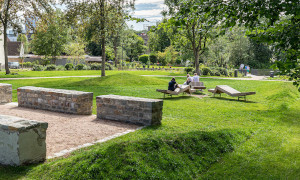By Volker Lange
The already often suboptimal site conditions of trees in the city are increasingly aggravated by the advancing climate change. But the current guiding principles of urban planning (redensification, inner development before outer development) also have a negative impact on the vitality of existing trees and green spaces. This is because they usually lose out when the available urban space is distributed.
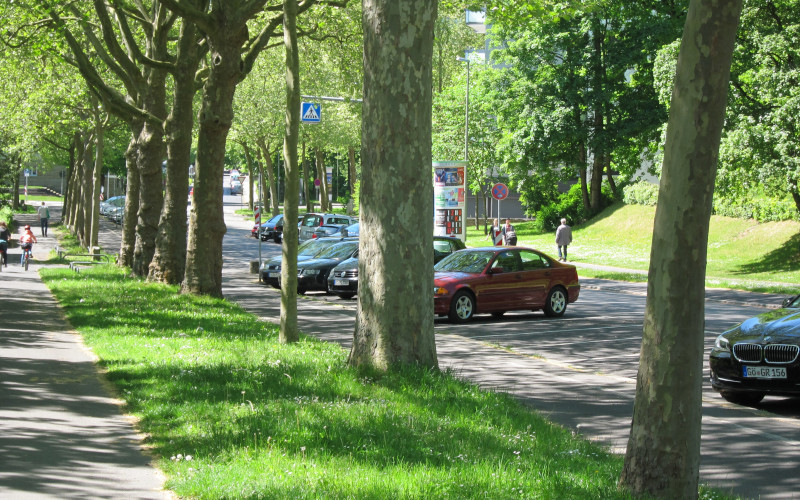
Thus, building densification usually takes place on unsealed areas and the so-called "double inner development" intensifies the use of existing open spaces, but rarely creates new ones. (Incidentally, the urbanization of green spaces, which is increasingly taking place in urban metropolises in particular, but now also in suburban communities, contradicts the German Federal Nature Conservation Act. Thus it says in § 1, (5): "... The renewed use of already built-up areas as well as the development of undeveloped areas in the planned and unplanned inner area, as far as they are not intended for green spaces, has priority over the use of open spaces in the outer area...". Furthermore, in § 1 (6) BNatSchG, the basic preservation of open spaces or even the creation of new open spaces is required in settled and unsettled areas, where they are not available in sufficient quantities. Against the backdrop of climate change, the BNatSchG thus provides a good argumentation basis against further intensive post-densification on green spaces).
At the same time, the pressure of use on open spaces is increasing due to new residential buildings and the general trend toward urbanization. Three-quarters of the German population already lives in densely populated areas. In addition, on hot summer days, there is the problem of greater heating of urban space, which is often 10 °C warmer than the surrounding countryside due to direct and indirect radiant energy.
This is a dilemma not only for our profession: those who plant trees think in terms of decades, if not centuries. So what to plant in current projects, along streets, in green spaces and (listed) parks? Which trees will still thrive in 30, 50, 100 years?
Volker Lange
This question is not only of concern to municipalities, universities and research institutes, but also to the tree nursery industry, which produces trees that can only be offered to the market after many years of cultivation. All well-known companies advertise with corresponding climate or future trees, which are supposed to be able to cope with the coming difficult requirements. These planning aids are a good orientation especially for the guild of landscape architects, who are not always praised for their detailed knowledge of plants. However, we must warn against the unchecked adoption of all suggestions. Why?
Future trees need expert knowledge
Planting planning is still a local matter, i.e. the different small-scale conditions shape the success of tree plantings - especially against the background of climate change - more than ever. It makes a big difference whether the site is exposed in the open countryside, in an urban park, on a narrow street, in a square, or in a sheltered backyard. Furthermore, the prevailing soil conditions are just as essential for long-term growth success as the region in Germany and the altitude.
Weighing up all these factors and bringing them into harmony with a suitable selection of plants requires experience and still horticultural intuition. Against this background, the teaching and further development of in-depth plant knowledge in training, studies and during professional life is becoming increasingly important. Future trees for the city need expertise.
What criteria can basically be used to select trees for the future? With regard to climate change, these are primarily:
- Resistance to heat and drought,
- compact growth habit,
- resistance to diseases and pests,
- no invasive species.
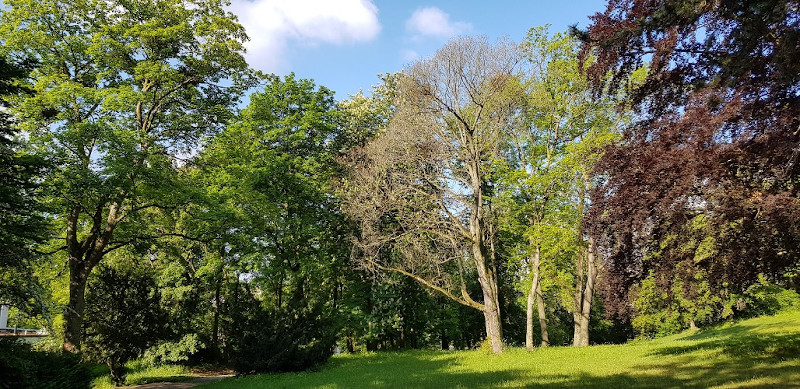
At this point, it becomes clear that the many native tree species that have so far shaped and still shape the image of our cities to a very great extent are very quickly reaching their limits, because things look rather bad, especially in terms of heat and drought tolerance. Especially sycamores and Norway maples, horse chestnuts, but also pedunculate oaks, ash trees, lime trees and even hornbeams have suffered considerably from the weather conditions of recent years. The realization that native tree species will no longer play a major role in urban areas in the future, especially as street and square trees, has now also become accepted in nature conservation circles. So-called exotics are increasingly dominating the image of our cities because they can (still?) cope better with the new conditions.
However, this should not obscure the fact that these tree species also have clear developmental and physiological limits. Even heat- and drought-resistant trees need sufficient water, a well-dimensioned site and optimal pruning during the growing phase. However, if the summer months reach the peak temperatures predicted by climatologists in the next few decades, even the exotics that are still hardy here will be at a loss. If temperatures remain too high, these trees will simply evaporate too much water, leading to irreversible embolisms in the piping system and the gradual death of the trees.
Future trees for the city need space
So what are the strategies for sustainable use of trees? The most important thing is still an optimal tree location, i.e., an area that is as large as possible and can be rooted freely, as well as sufficient space for the species-typical crown to develop permanently. The much quoted 12m2 root space volume is a minimum value (!). For a small-crowned tree, this value may still be sufficient, but even a medium-sized tree such as a Gleditsia "Skyline" will find it too cramped after a few years, not to mention a plane tree or lime tree.
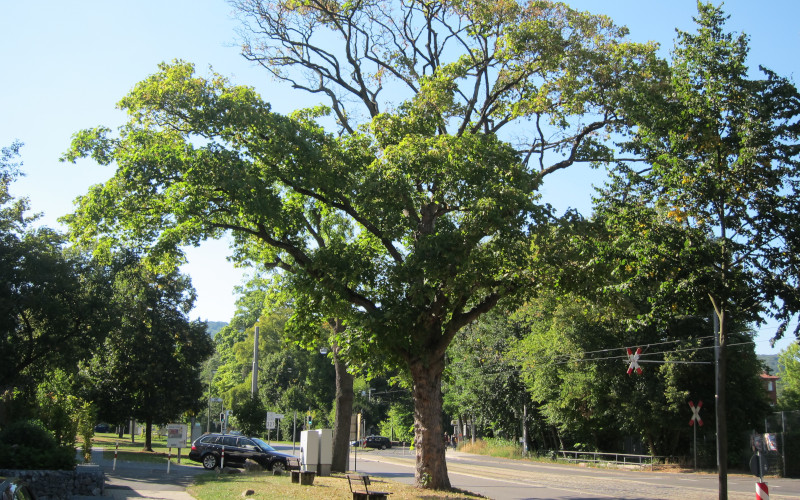
The consequence of planting trees in too small tree discs can be observed all over the country: the trees become senile after a few decades, form shorter and shorter annual shoots and soon after deadwood, become susceptible to disease and are finally felled. The average life expectancy of street trees in some cities is now only 40 to 50 years, which is far too short a value when the costs of planting and maintenance are taken into account. Future trees for the city need space.
The optimization of tree locations must be seen against the background of the role of urban greenery in climate change.
Urban trees are the most essential factor of the so-called green infrastructure, and their importance is growing in terms of the resilience of urban spaces and the health of the population.
Volker Lange
Future trees for the city need water
The "welfare effects of trees" - providing shade for people, buildings, and surfaces, reducing heat radiation, filtering dust and pollutants, etc. etc. - have been well known and scientifically proven for decades. That is why tree planting is still a popular and positive means of demonstrating commitment to the environment. However, it is usually forgotten that trees can only provide their important ecosystem services if they are vital and can develop optimally.
Planting trees and especially watering them is a significant climate adaptation measure, because the production of oxygen and evaporation of water in the process of photosynthesis can only take place if sufficient water is available. Large trees consume up to 400 liters of water per day on hot summer days, a significant amount that must be available in the soil or supplied. No matter what species of trees are planted, all must first be carefully watered for several years to grow. Adequate watering of trees is therefore one of the best, most important, and most sustainable climate adaptation measures.
Future trees for the city need prospects
This makes it all the more fatal that the usual urban development funding programs subsidize the planning and planting of trees, but not the minimum three-year development care. Due to the increasing heat and dry periods, trees would now have to be watered for five to six years before they are rooted in and can take care of themselves. Against the background of the serious lack of personnel in municipalities (in the meantime, however, also specialized enterprises) and the high expenditure of the irrigation measures a rethinking of the sponsors on state, federal and EU level is finally necessary here: The investment financings of the many projects are worth nothing without the long-term support of the urgently necessary care measures, they do not contribute to the positive development of the city climate, if the trees care after few years for lack of capacity and dry up finally completely.
Future trees for the city need experience
But which trees are suitable for planting along streets, in squares, in the city in general? The search for suitable street trees has been dealt with for quite some time by the Working Group on Urban Trees in the GALK (Garden Office Managers Conference). Already in the GALK street tree test 1 (1995-1999) eight cities tested 13 different trees regarding their suitability for use as street trees (see https://www.galk.de/arbeitskreise/stadtbaeume). In the meantime, the GALK Street Tree Test 2 is running, this time in 16 cities. Now 40 tree species with at least five trees at one location are observed and bonitated from August to September.
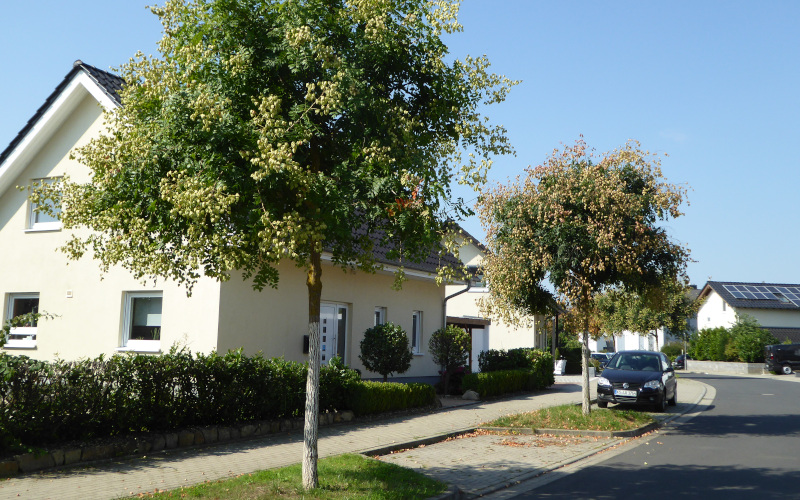
An interactive map facilitates the localization of tree sites in the participating cities. In addition, photos of the locations give an impression of the development of the trees. This makes it easier to transfer the test results to one's own questions, which can also be compared between the cities and related to the location of one's own city. After all, trees that develop favorably in the north of Germany may fail in the south and vice versa. The results of the street tree tests have been incorporated into the GALK street tree list, which is now also available interactively and contains over 170 trees. Future trees for the city need experience.
In addition to the tree species that have been proven and recommended in tests, street trees that could potentially have good chances as future trees are also being planted on an experimental basis in Kassel, for example, the Japanese cord tree (Sophora japonica), the hackberry tree (Celtis australis) and the lampion tree (Koelreuteria paniculata). The bluebell tree (Paulownia tomentosa) is also developing rapidly and splendidly, delighting with its lush, unusual blooms. Here it will have to be seen how permanently stable the crowns develop. The bee tree (Tetr-dium hupehensis), an attractive tree for smaller streets and squares, which is valuable for insects due to its late flowering, has also been "scoring" for many years. The Japanese raisin tree (Hovenia dulcis) also appears to have potential, but it is too early to recommend it. Other test trees include Toona sinensis, Nyssa sylvatica, Eucommia ulmoides, and others. Future trees for the city need courage to experiment.
However, we must not forget conifers, which usually have a bad image but also offer advantages as urban trees: As mostly evergreen trees, they also set accents in winter, assimilate year-round and also bind dust permanently. They require little pruning and are often very heat and drought resistant. Decisive for planting conifers is the right environment and a well thought-out design concept.
Future trees in the city need planning
At this point at the latest, a digression on the subject of procuring trees is necessary. As mentioned at the beginning, their cultivation is time-consuming and demanding, which limits an assortment grown in all qualities from an economic point of view. Due to the increasing significant drought damage, many more trees currently need to be replanted. There is an enormous demand for trees in all sizes, many quarters are already sold out, and prices are rising noticeably. As a result, many orders also cannot be implemented with the planned tree species, and decisions often have to be made about replacement species or varieties shortly before planting. Large quantities of rarer tree species in street tree quality are not available anyway. Here it is worthwhile to invest more time again in the planning and development of street tree concepts and to conclude far-reaching cultivation contracts with tree nurseries. Future trees in the city need planning.
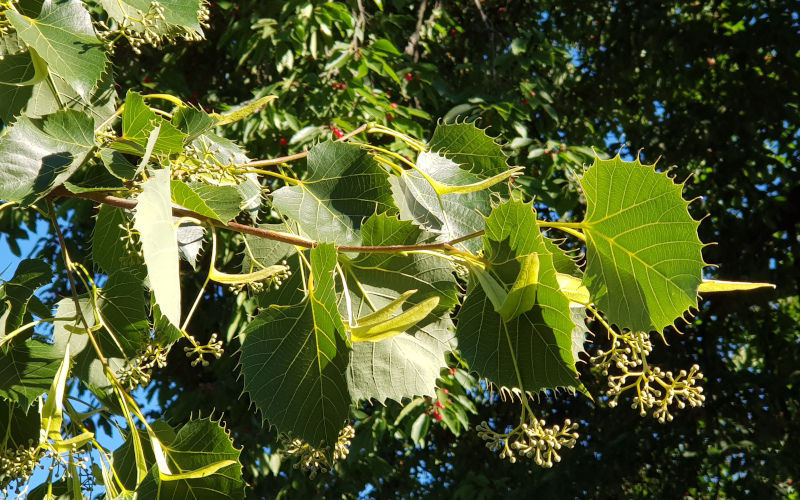
And our native tree species? Despite all the problems caused by climate change, it is impossible to imagine the regional nature and landscape without them. Even if they are not used as street and square trees, they are essential for parks and green spaces, landscape conservation areas and near-natural recreational areas.
Due to the natural spreading urge or the mostly luxuriant generative reproduction, there is the chance to use the adaptation potential of the trees and to preserve and promote heat- and drought-resistant specimens by active selection of the most promising individuals over time. This, of course, requires basic horticultural knowledge and planning foresight, as well as a conceptual eye in standard maintenance or winter pruning programs. Future trees for the city need flexibility.
Future trees for the city need imagination
In this context, the planting of mixed rows of trees or avenues is also being tested in Kassel. Depending on the location, spatial reference and urban structure, native and "exotic" tree species are combined here, sometimes also with conifers, in order to achieve as diverse an appearance as possible. Due to the variety of trees, diseases and pests cannot spread as quickly and only affect individual trees, thus avoiding possible total failures. Especially in autumn, such an avenue offers a fantastic sight for weeks. Future trees for the city need imagination.
Conclusion
Due to ongoing climate change, native trees will continue to lose importance for use in urban areas. "Exotics" are the winners of climate change because they are usually already more resistant to heat and drought due to their origin and the climates there. But even more robust tree species initially need sufficient water and careful care.
Variety is therefore the key! The mixture of native and (still) rare trees to form colorful avenues is not only a compromise between nature conservation requirements and new tree species, they also offer the potential of highest biodiversity.
Tree selection is and remains a regional competence. Local experiences must be developed and used without losing the courage to experiment. A very good orientation is provided by the experiences of tree experiments such as the GALK working group on urban trees, Stadtgrün 21, etc. However, the most important thing is still an optimal tree location. Trees can only fulfill their important tasks in the urban green if they are given sufficient space.
Author: Volker Lange, Landscape Architect bdla, Kassel, Head of the Department of Open Space Planning, Environmental and Garden Authority Kassel, Member of the Working Group Urban Trees of GALK e .V. The text was published in the bdla association journal "Landschaftsarchitekten" 1/2022.
- Latitude: 0
- Longitude: 0
